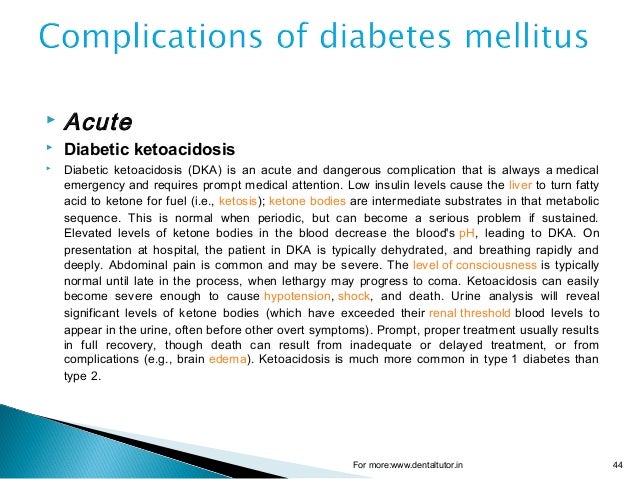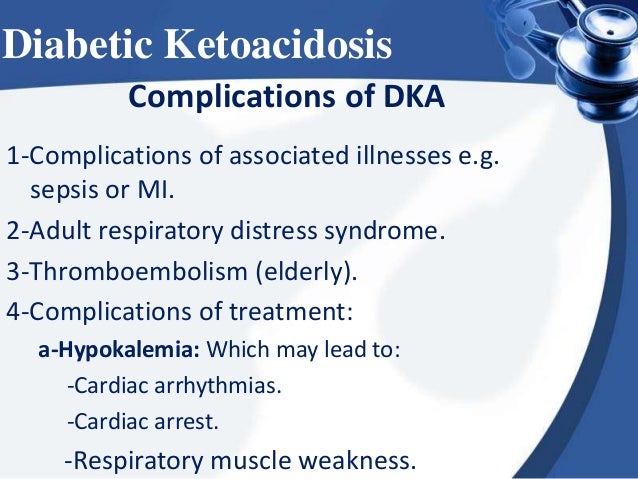Diabetes Ketoacidosis Complications
Early symptoms include the following: thirst or a very dry mouth frequent urination high blood glucose (blood sugar) levels high levels of ketones in the urine. Diabetic ketoacidosis (dka) is a dangerous complication of diabetes caused by a lack of insulin in the body. diabetic ketoacidosis occurs when the body is unable to use blood sugar (glucose) because there isn't enough insulin. instead, it breaks down fat as an alternative source of fuel. this causes a build-up of a by-product called ketones. Diabeticketoacidosis and causes. diabetic ketoacidosis diabetes ketoacidosis complications is the name given to the very serious condition that occurs as one of the results of diabetes. ketoacidosis appears when the body produces the high amounts of ketones, which are blood acids. this disorder occurs as the consequence of the little insulin in body. A state of inadequate insulin levels resulting in high blood sugar and accumulation of organic acids and ketones in the blood. provides the causes, symptoms, and treatment.
Diabetic Ketoacidosis Symptoms And Causes Mayo Clinic
Diabetes complications low blood sugar (hypoglycemia). people with diabetes can experience sudden drops in their blood sugar. skipping a meal ketoacidosis. this is a complication of diabetes that occurs when your body cannot use sugar, or glucose, as a fuel eye problems. diabetes can damage. Introduction. diabetic ketoacidosis (dka) is the leading cause of morbidity and mortality in children with type 1 diabetes, with a case fatality rate ranging from 0. 15 percent to 0. 31 percent in the united states and other resource-rich countries []. dka also can occur in children with type 2 diabetes; this presentation is most common among adolescents of african american descent [].
Diabetes Complications Hypoglycemia Ketoacidosis And More
People with type 1 diabetes are at risk for ketoacidosis, since their bodies don't diabetes ketoacidosis complications make any insulin. your ketones can also go up when you miss a meal, you're sick or stressed, or you have an. and oral health diabetes mellitus treatment diabetes ocular complications diabetes pathophysiology diabetic coma diabetic ketoacidosis oral diseases and diabetes periodontal health and diabetes
Diabeticketoacidosis Your Md
Treatment complications include: low blood sugar (hypoglycemia). insulin allows sugar to enter your cells, causing your blood sugar level to drop. if low potassium (hypokalemia). the fluids and insulin used to treat diabetic ketoacidosis can cause your potassium level swelling in the brain. Diabeticketoacidosis (dka) is a serious complication of type 1 diabetes and, much less commonly, of type 2 diabetes. dka happens when your blood sugar is very high and acidic substances called.

Diabeticketoacidosis is a serious condition that can occur as a complication of diabetes. people with diabetic ketoacidosis (dka) have high blood sugar levels and a build-up of chemicals called ketones in the body that makes the blood more acidic than usual.
Diabeticketoacidosis Wikipedia
As your body breaks down fat and protein for energy, your blood sugar level will continue to rise. ketone level. when your body breaks down fat and protein for energy, acids known as ketones enter your bloodstream. blood acidity. if you have excess ketones in your blood, your blood will become acidic (acidosis). Diabetic ketoacidosis (dka) is a serious complication of type 1 diabetes and, much less commonly, of type 2 diabetes. dka happens when your blood sugar is very high and acidic substances called. The lifesaving treatment of diabetic ketoacidosis also can lead to the following complications: low blood sugar ( hypoglycemia) cerebral edema (swelling of brain) low potassium ( hypokalemia ).
Ketoacidosis. this is a complication of diabetes that occurs when your body cannot use sugar, or glucose, as a fuel source because your body has no insulin or not enough insulin. if your cells are. Dka (ketoacidosis) & ketones diabetic ketoacidosis (dka) is a serious condition that can lead to diabetic coma (passing out for a long time) or even death. when your cells don't get the glucose they need for energy, your body begins to burn fat for energy, which produces ketones. Nerve damage from diabetes is called diabetic neuropathy (new-rop-uh-thee). about half of all people with diabetes have some form of nerve damage. read more. foot complications. learn about neuropathy (which can cause numbness in the feet) as well as other complications. read more. dka (ketoacidosis) & ketones.
Complications Ada American Diabetes Association
Complications ada american diabetes association.

Diabeticketoacidosis is a life-threatening complication of type 1 diabetes (though rare, it can occur in people with type 2 diabetes) that occurs when the body produces high levels of ketones due to lack of insulin. ; diabetic ketoacidosis occurs when the body cannot produce enough insulin. ; the signs and symptoms of diabetic ketoacidosis include. If you do get covid-19, the infection could put you at greater risk for diabetes complications like diabetic ketoacidosis (dka). dka happens when high levels of acids called ketones build up in. Trends in hospital admission for diabetic ketoacidosis in adults with type 1 and type 2 diabetes in england, 1998-2013: a retrospective cohort study. diabetes care. 2018 jan 31. 48 (4):87-9. Diabeticketoacidosis (dka) is a serious problem that diabetes ketoacidosis complications can happen in people with diabetes if their body starts to run out of insulin. when this happens, harmful substances called ketones build up in the body, which can be life-threatening if it's not found and treated quickly.
Diabeticketoacidosis nhs nhs.
Diabeticketoacidosis (dka) is a buildup of acids in your blood. it can happen when your blood sugar is too high for too long. it could be life-threatening, but it usually takes many hours to. Diabetic ketoacidosis (dka) is a dangerous complication diabetes ketoacidosis complications faced by people with diabetes which happens when the body starts running out of insulin. dka is most commonly associated with type 1 diabetes, however, people with type 2 diabetes that produce very little of their own insulin may also be affected. Diabeticketoacidosis (dka) is a complication of diabetes that can occur if the body starts to run out of insulin (the hormone that regulates blood sugar).. it can be caused by a number of underlying problems including an infection, a missed insulin injection or undiagnosed diabetes (see below).

If your doctor suspects diabetic ketoacidosis, he or she will do a physical exam and various blood tests. in some cases, additional tests may be needed to help determine what triggered the diabetic ketoacidosis. blood tests. blood tests used in the diagnosis of diabetic ketoacidosis will measure:. Uncommonly, diabetic ketoacidosis can occur if you have type 2 diabetes. in some cases, diabetic ketoacidosis may be the first sign that a person has diabetes. complications. diabetic ketoacidosis is treated with fluids, electrolytes — such as sodium, potassium and chloride — and insulin. Skin complications. stay alert for symptoms of skin infections and other skin disorders common in people with diabetes. read more. eye complications. keep your risk of glaucoma, cataracts and other eye problems low with regular checkups. read more. neuropathy. nerve damage from diabetes is called diabetic neuropathy (new-rop-uh-thee).
Diabeticketoacidosis (dka) is a dangerous complication faced by people with diabetes which happens when the body starts running out of insulin. dka is most commonly associated with type 1 diabetes however, people with type 2 diabetes that produce very little of their own insulin may also be affected. ketoacidosis is a serious short Diabeticketoacidosis (dka) is a potentially life-threatening diabetes ketoacidosis complications complication of diabetes mellitus. signs and symptoms may include vomiting, abdominal pain, deep gasping breathing, increased urination, weakness, confusion and occasionally loss of consciousness. a person's breath may develop a specific "fruity" smell. onset of symptoms is usually rapid.

Comments
Post a Comment